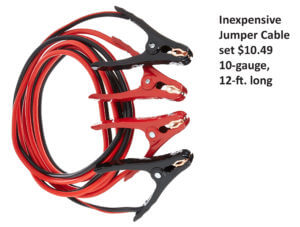Why Car Won’t Start With a Jump — Most common causes
Why a car won’t start with a jump
Jumper cables are designed to help start a car or truck with a weak battery. But if your car won’t start with a jump, it’s usually because your battery is dead, internally damaged, the battery posts/terminals are loose/corroded, or the starter is dead. Here are the most common reasons why a jump start doesn’t work.
Before we dig in, let’s get our terms straight: When I’m talking about why your car won’t start with a jump, I’m talking about why it won’t crank (rotate) at the right speed, not why it won’t fire up. There are many reasons why a cranking engine won’t fire up. Here are the most common:
Worn spark plugs — It’s much harder to start combustion in a cold engine and it’s even harder to do that with worn spark plugs. Worn plugs that worked fine in warm weather will produce a much weaker spark in cold weather and that can prevent your engine from starting
Flooded engine — If you tried to start the engine and it didn’t start right up in cold weather, chances are high that additional attempts are just adding too much gas to the engine. If it worn fire up after several tries, depress the gas pedal to the floor and hold it there while cranking the engine. That allows more air in that can help vaporize the excess fuel.
Bad gas/summer gas — Winter gas is more volatile than summer gas. If you filled your tank in the fall and now it won’t start in cold weather, it could be due to less volatile summer gas. Once you get it running, use up the summer gas and refill with winter gas.
You connected the jumper cables, but you didn’t make a good clamp connection
Keep in mind that you’re trying to transfer at least 100 amps from one car to another. That requires a really good connection from the clamp to the positive battery terminal and the other clamp to a solid ground. That’s not always easy to do on a modern engine with lots of plastic parts and painted metal parts. So double check your connections.
You didn’t wait long enough for the discharged battery to charge up a bit
The instant you connect your jumper cables to the dead vehicle, you’re starting to charge the battery. In other words, the power from the donor vehicle is going right into the battery, not to the starter motor. Too many DIYers simply don’t wait longer enough to let the discharged battery charge up a bit. To put it in simple terms, you’re not flowing enough power from the donor vehicle into the dead vehicle to charge the battery while also trying to power the starter.
Let the dead battery charge for 10 minutes before trying to crank the engine.
The battery terminals and posts are corroded or loose
Loose and corroded terminal connections create high resistance that decreases the amount of power to the battery and the starter.
Cheap jumper cables can’t start your car because they have too much voltage drop
Wire thickness, wire metal type, and cable length all have a direct bearing

Here’s a set of inexpensive jumper cables—$10.49. Now scroll down to the chart and see what voltage they deliver to the dead vehicle.
on how much power the cable will transmit to the dead battery and starter. Wire gauge numbering is inverse, so the smaller the number, the thicker the wire. Thicker wire has less internal resistance so it carries more current. But current carrying capacity is also affected by jumper cable length. The longer the cable, the more internal resistance and the lower the amp carrying capacity. We’ll come back to that in the chart below. See this post to learn how much current jumper cables can carry and why cheap cables won’t start your car.
The dead battery has an internal short
Old batteries shed lead plate material and that material can build up on the bottom of the battery. When it reaches plate level, it can short out the positive and negative plate. If you try to jump start that vehicle, it most likely will never start due to the shorted battery cell. It just drains too much power. See this post on what causes a car battery to die with no symptoms
Engine cranks with a jump start but won’t fire up
If the engine cranks with no sign whatsoever that it’s attempting fire up, go here for the next step.
If the engine cranks but occasionally feels like it’s trying to fire up, go here for the next step.
©, 2020 Rick Muscoplat
Posted on by Rick Muscoplat